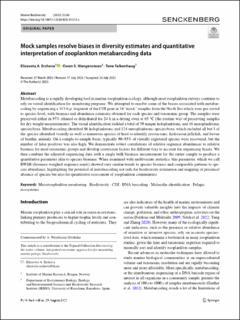| dc.contributor.author | Ershova, Elizaveta | |
| dc.contributor.author | Wangensteen, Owen S. | |
| dc.contributor.author | Falkenhaug, Tone | |
| dc.date.accessioned | 2023-09-26T13:26:50Z | |
| dc.date.available | 2023-09-26T13:26:50Z | |
| dc.date.created | 2023-09-14T09:37:59Z | |
| dc.date.issued | 2023 | |
| dc.identifier.citation | Marine Biodiversity. 2023, 53 (5), . | en_US |
| dc.identifier.issn | 1867-1616 | |
| dc.identifier.uri | https://hdl.handle.net/11250/3092107 | |
| dc.description.abstract | Metabarcoding is a rapidly developing tool in marine zooplankton ecology, although most zooplankton surveys continue to rely on visual identification for monitoring purposes. We attempted to resolve some of the biases associated with metabarcoding by sequencing a 313-b.p. fragment of the COI gene in 34 “mock” samples from the North Sea which were pre-sorted to species level, with biomass and abundance estimates obtained for each species and taxonomic group. The samples were preserved either in 97% ethanol or dehydrated for 24 h in a drying oven at 65 °C (the routine way of preserving samples for dry weight measurements). The visual identification yielded a total of 59 unique holoplanktonic and 16 meroplanktonic species/taxa. Metabarcoding identified 86 holoplanktonic and 124 meroplanktonic species/taxa, which included all but 3 of the species identified visually as well as numerous species of hard-to-identify crustaceans, hydrozoan jellyfish, and larvae of benthic animals. On a sample-to-sample basis, typically 90–95% of visually registered species were recovered, but the number of false positives was also high. We demonstrate robust correlations of relative sequence abundances to relative biomass for most taxonomic groups and develop conversion factors for different taxa to account for sequencing biases. We then combine the adjusted sequencing data with a single bulk biomass measurement for the entire sample to produce a quantitative parameter akin to species biomass. When examined with multivariate statistics, this parameter, which we call BWSR (biomass-weighed sequence reads) showed very similar trends to species biomass and comparable patterns to species abundance, highlighting the potential of metabarcoding not only for biodiversity estimation and mapping of presence/absence of species but also for quantitative assessment of zooplankton communities. | en_US |
| dc.language.iso | eng | en_US |
| dc.title | Mock samples resolve biases in diversity estimates and quantitative interpretation of zooplankton metabarcoding data | en_US |
| dc.title.alternative | Mock samples resolve biases in diversity estimates and quantitative interpretation of zooplankton metabarcoding data | en_US |
| dc.type | Peer reviewed | en_US |
| dc.type | Journal article | en_US |
| dc.description.version | publishedVersion | en_US |
| dc.source.pagenumber | 18 | en_US |
| dc.source.volume | 53 | en_US |
| dc.source.journal | Marine Biodiversity | en_US |
| dc.source.issue | 5 | en_US |
| dc.identifier.doi | 10.1007/s12526-023-01372-x | |
| dc.identifier.cristin | 2174963 | |
| dc.relation.project | Norges forskningsråd: 299554 | en_US |
| cristin.ispublished | true | |
| cristin.fulltext | original | |
| cristin.qualitycode | 1 | |
